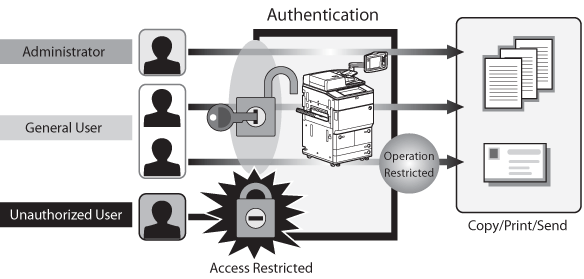The authentication on this machine requests user information (user name and password) when users access the machine, and verifies that information. Only the authorized user that successfully passed the authentication can operate the machine. You can prevent access by unauthorized users by managing the users for the machine. To use the authentication mode, you must first register the information for administrator and general users.
The administrator can restrict various functions such as Copy, Print, and Send that each user can use and limit the maximum number of copies/prints that each user can output. Also, if necessary, the administrator can restrict settings on "Settings/Registration."
The administrator manages the users by restricting access by general user and setting restrictions on operations using the authentication mode. General user privileges can be set per users. By preventing access by unauthorized users, administrators can reduce the threat of tampering of the machine and information leakage.

The authentication is used for the following:
Dept. ID Management
You can manage the users by department or project by registering the Department ID and password. The Department ID Management enables you to restrict various functions such as Copy, Print, and Send that each department can use, and the Page Limits for Copy, Scan, and Print for each department. (See "Department ID Management.")
You can manage the users by department or project by registering the Department ID and password. The Department ID Management enables you to restrict various functions such as Copy, Print, and Send that each department can use, and the Page Limits for Copy, Scan, and Print for each department. (See "Department ID Management.")
SSO-H(Single Sign-On H)
There are two types of authentication method: Domain Authentication, which performs login authentication for the machine and authentication of the domain on the network in conjunction with the domain controller of the Active Directory, and Local Device Authentication, which performs authentication using only the machine. You can use both authentication methods at the same time. (See "SSO-H (Single Sign-On H).")
Also, you can limit use of particular device functions for each user using the Access Management System. For example, you can restrict Copy/Print functions such as 2-sided output or the use of each "Settings/Registration" setting.
There are two types of authentication method: Domain Authentication, which performs login authentication for the machine and authentication of the domain on the network in conjunction with the domain controller of the Active Directory, and Local Device Authentication, which performs authentication using only the machine. You can use both authentication methods at the same time. (See "SSO-H (Single Sign-On H).")
Also, you can limit use of particular device functions for each user using the Access Management System. For example, you can restrict Copy/Print functions such as 2-sided output or the use of each "Settings/Registration" setting.
This mode enables you to link information such as the user name and password set for each function by each user with the SSO-H user information.
You can delete the user setting information that each user is using from the User Setting Information Management Service page. (See "User Setting Information Management Service.")
You can delete the user setting information that each user is using from the User Setting Information Management Service page. (See "User Setting Information Management Service.")
User Access Control for Advanced Space enables you to manage authentication on users when the Advanced Space on the machine is used, or when the Advanced Space is open to the public on the network and being used as a server. (See "User Access Control for Advanced Space.")
You can set the following types of administrator on this machine. By specifying the administrator, you can restrict operations by general users on the Settings/Registration screen and set Settings/Registration for administrator privileges. For information on registering user information for the Administrator, Network Manager, and Device Manager, see "MEAP." Also, for information on items that you can set on Settings/Registration, see "Management Settings."
System Manager/Administrator*
Network Manager (NetworkAdmin)*
Device Manager (DeviceAdmin)*
* You can set when using SSO-H.
The System Manager can specify all of the system settings for the machine. As a default, system manager settings (System Manager ID/System PIN) are set on the machine. Thus, the Administrator must log in by entering the System Manager ID and the System PIN on the Settings/Registration screen. The default setting for both the System Manager ID and System PIN is '7654321'. We recommend that you change both the System Manager ID and System PIN.
For instructions on specifying the System Manager Settings, see "Specifying the System Manager Settings."
For instructions on specifying the System Manager Settings, see "Specifying the System Manager Settings."
Administrator
Administrator can specify all of the system settings for the machine.
Administrator can specify all of the system settings for the machine.
To specify the authentication settings using SSO-H, set the System Manager Settings and use SMS(Service Management Service) from the Web browser. (See "MEAP.")
Network manager mainly manages the settings related to the network. You can specify the IP address settings required to connect to the network or the settings for IPSec and SNMP for security.
The Device Manager can specify settings related to management settings for paper type and function settings for Send/Receive.